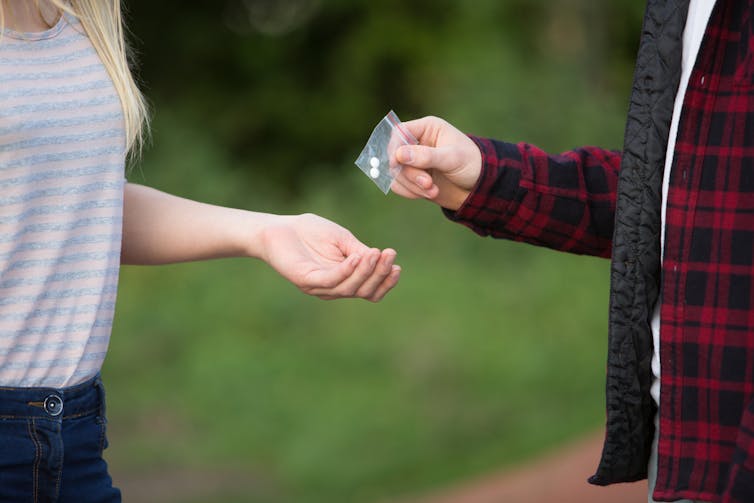How parents and teachers can identify and help young people self-medicating trauma with drugs and alcohol
- Written by Katherine Mills, Associate Professor at The Matilda Centre for Research in Mental Health and Substance Use, University of Sydney
Some 80% of young people will experience a traumatic event by the time they become an adult. Rates of exposure to trauma peak during adolescence. The stress from traumatic events can result in a loss of interest in school, friends, hobbies, and life in general.
The types of traumatic events include a wide range of terrifying and life-threatening experiences such as physical or sexual assault, witnessing violence, motor vehicle and other serious accidents, and natural disasters. They may be one-off events like car accidents, or prolonged as is often the case with childhood abuse and domestic violence.
Read more: Children with severe trauma can be fostered, and recover with the right treatment and care
Many young people keep their feelings hidden and try to cope with it themselves, sometimes by self-medicating with alcohol or other drugs. These young people often experience a range of difficulties at home and school. Without identification and treatment of the underlying issues, developmental and educational trajectories can be severely disrupted and these problems may persist into adulthood. It’s estimated between 30-50% of adolescents with PTSD also abuse or are dependent on alcohol.
There are several signs parents and teachers can look for to identify young people at risk and treatment options are available.
How does trauma impact young people?
Traumatic stress and alcohol or other drug use during adolescence have been linked to a range of physical and psychological health problems, poorer performance at school and work, family and social problems, aggression, and criminal behaviour.
Adolescence is a critical developmental window where a person experiences profound social, biological, and neurological changes. During this period, a person is particularly vulnerable to the impact of trauma. Trauma during adolescence has been associated with significant changes in the structure and functioning of the brain.
Adolescents who have experienced trauma have also been found to have higher rates of anxiety, depression and suicidal ideation, be in poorer physical health, and have difficulties with relationships with family, friends or classmates. Increases in aggression and risk-taking behaviours are also common. Of concern, these problems are linked with increased risk for illness and premature death in adulthood.
 Young people may isolate themselves to avoid talking about traumatic events they have experienced.
from www.shutterstock.com
Young people may isolate themselves to avoid talking about traumatic events they have experienced.
from www.shutterstock.com
It’s common for a young person to experience changes in their thoughts, feelings and behaviour after a traumatic event, but everyone responds differently. Some of the most common reactions to trauma are increases in feelings of fear and anxiety.
Many young people will try to avoid thinking and talking about what happened, and stay away from people, places and things that remind them of what happened. They may be constantly on-edge and on the look-out for danger. Trouble sleeping and concentrating are also common. These feelings are a normal response to an abnormal event.
Many adolescents will feel much better within a few months after the event, but symptoms will persist for approximately one in seven adolescents, developing into post traumatic stress disorder (PTSD). Some reactions may also be delayed, appearing months or even years after the event.
Read more: Explainer: what is post-traumatic stress disorder?
Regardless of whether a person does develop PTSD, traumatic events are often life-changing and can redefine a person’s views of themselves. This includes feeling weak, bad, worthless, or to blame for what happened, the world around them is not safe, or that people cannot be trusted. These beliefs can become particularly well-entrenched in those who have experienced childhood trauma.
Why do young people self-medicate?
Because many young people keep the event (and/or their feelings and reactions to it) a secret, the extent of child and adolescent trauma has been referred to as a “silent” or “hidden” epidemic. Because many adolescents who have experienced trauma may not be inclined to talk openly about these experiences, it’s not always obvious to parents and teachers that post-traumatic stress may be a key reason these young people struggle at school.
In the absence of support from family, teachers and peers (either because these resources are not available to the young person, or they choose not to access them), young people try to cope with what has happened them, sometimes by self-medicating with alcohol or other drugs.
 One warning sign is if a young person starts or increases their drug or alcohol intake.
from www.shutterstock.com
One warning sign is if a young person starts or increases their drug or alcohol intake.
from www.shutterstock.com
As with trauma, the adolescent brain is particularly susceptible to the neurotoxic effects of alcohol and other drugs. Adolescents who are self-medicating can find themselves in a vicious cycle where they need increasingly large amounts of alcohol or other drugs to try and combat increasing symptoms of traumatic stress.
Read more: How childhood trauma changes our hormones, and thus our mental health, into adulthood
Once established, both problems maintain and exacerbate the other.
How can parents and teachers help?
The Australian National University Trauma and Grief Network and Victorian government have developed a detailed list of signs of trauma in children and adolescents. This may help parents and teachers identify young people who may be at risk. These signs include:
- strong emotions such as sadness, anger, fear, anxiety and guilt
- repetitively thinking about the traumatic event and talking about it often
- disturbed sleeping patterns and/or nightmares
- emotional, behavioural and personality changes
- withdrawing from family and friends and wanting to spend more time alone
- self-absorption
- being very protective of family and friends
- returning to younger ways of behaving
- increased need for independence
- increased risk-taking behaviour
- initiation or increased use of alcohol or other drugs
- loss of interest in school, friends, hobbies, and life in general
- deterioration in school performance
- pessimistic outlook on life, being cynical and distrusting of others
- depression and feelings of hopelessness
- difficulties with short-term memory, concentration and problem solving.
Evidence-based psychological therapies are available for traumatic stress among adolescents. Trauma-focused cognitive behavioural therapy is the recommended first line treatment.
A good starting point for accessing these services is through a GP. After first talking to a young person about how they feel after experiencing a trauma themselves, parents and teachers can arrange an appointment and encourage the young person to speak to a GP about what may be bothering them. The GP can then refer the young person to a psychologist or other mental health professional who is experienced in working with children and adolescents who have experienced trauma.
The Centre of Research Excellence in Mental Health and Substance Use in Sydney is conducting a world-first trial of integrated psychological therapy for traumatic stress and substance use among adolescents aged 12-18 years. We hope the findings from this study will improve our understanding of how best to treat adolescents experiencing traumatic stress and substance use and prevent the chronic health problems associated with these conditions.
Authors: Katherine Mills, Associate Professor at The Matilda Centre for Research in Mental Health and Substance Use, University of Sydney



















